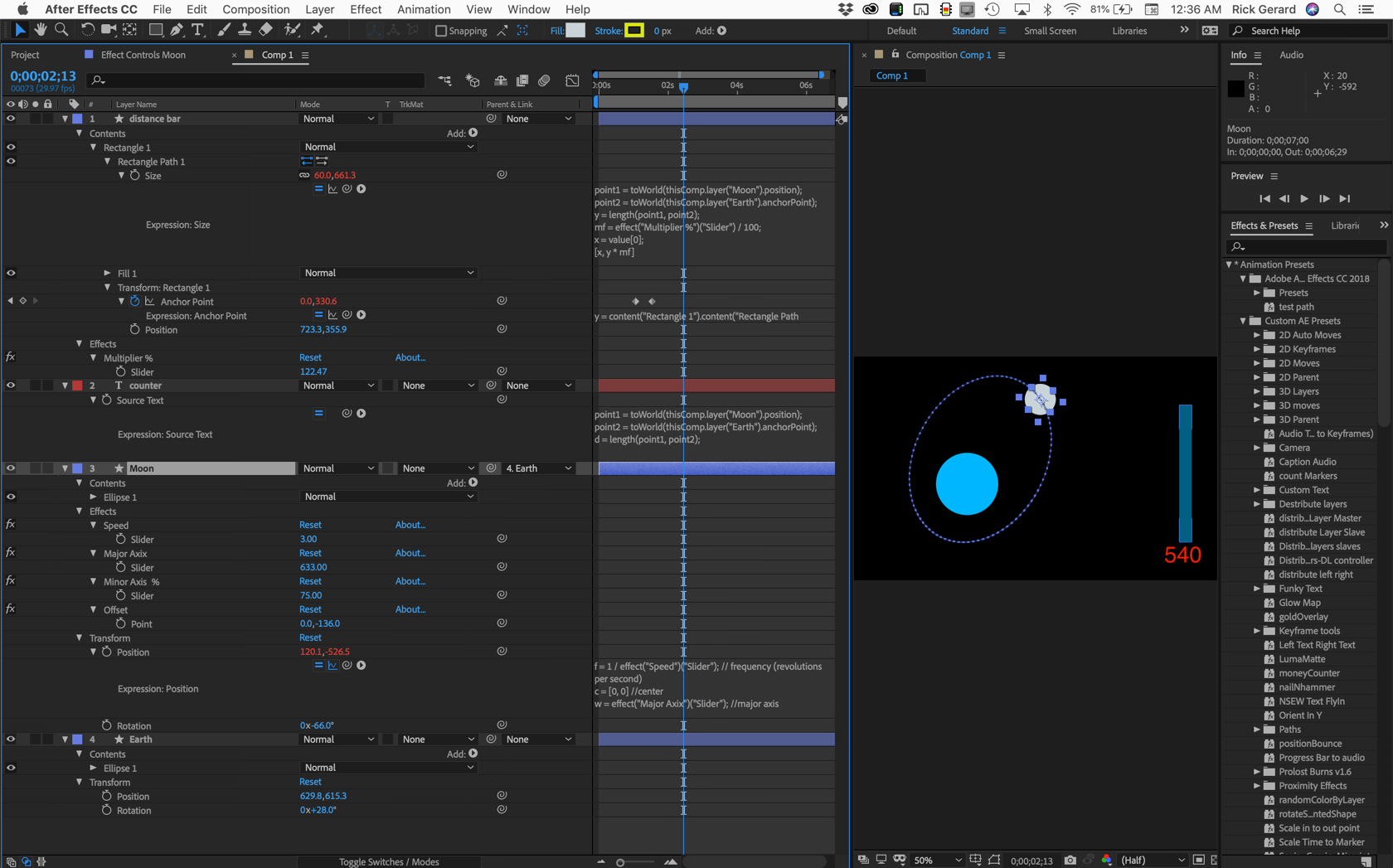- Home
- After Effects
- Discussions
- Eccentric (elliptical) orbit around null object?
- Eccentric (elliptical) orbit around null object?
Eccentric (elliptical) orbit around null object?

Copy link to clipboard
Copied
I have made a planetary orbit animation such as in this video: https://www.youtube.com/watch?v=BJUtbBo-PAw, except mine is top-down view. It is intended to show the orbits of moons in correct time and approximate 2D position.
Essentially two circles, viewed from the top, one paired to a null object that shares the anchor point with the other circle, orbiting using Z rotation.
I need to change the orbit from circular to elliptical, with an eccentricity of 0.75
How would I do this?
I found a recommendation on creativecow https://forums.creativecow.net/archivethread/2/482236#482525
But I'm not sure where to enter that code, or if that will even work. I think I enter the position expression by alt-clicking something, but I dont know where it goes or how to format it.
I am very new to AE, this is my first project although I have been using PS for a very long time.
Any help greatly appreciated!
Copy link to clipboard
Copied
The code does work - it's from Mr. Dan Ebberts : )
No need to concern yourself with nulls, parenting and rotation in this case - simply create the layer you want to be in orbit, Alt click on the stopwatch for position and paste in that code in the box to the right (overwrite the code that is in there by default).
Change the number on the first line to adjust the orbit frequency, and change w and h in a 1 to 0.75 ratio to get your required eccentricity.


Copy link to clipboard
Copied
I got it working. I now realize that the final line is the array that is the position expression. Everything else is just inconsequentially named variables used to populate the final array.
What if I wanted to display the position of the object on screen? Is there a way to link some text on the screen to one of those variables in the position expression?
Precisely, I want to display the distance of the moon from the planet it is orbiting, as well as the time value (taking the values and multiplying them by whatever value is necessary to get them from pixels to astronomical units, and from seconds to days; so I would actually need the displayed text to link to variables, not just the pixel position)
Thank you very much!
Copy link to clipboard
Copied
Personally, I would modify Dan's expression, add some expression sliders, use parenting, attach a bar to the number display to make it easier to visualize, and basically automate the whole thing. I already have and have saved it as an animation preset. The other expressions that I use in this example are also in my library of custom animation presets. It took me less than 3 minutes to create this comp from my animation presets:

The modified expression for an elliptical orbit:
f = 1 / effect("Speed")("Slider"); // frequency (revolutions per second)
c = [0, 0] //center
w = effect("Major Axix")("Slider"); //major axis
h = w * 100 / effect("Minor Axis %")("Slider"); //minot axis
ofst = effect("Offset")("Point");
t = time*f*2*Math.PI;
ofst + [Math.cos(t)*w, Math.sin(t)*h]/2 + c
The expression for the counter:
point1 = toWorld(thisComp.layer("Moon").position);
point2 = toWorld(thisComp.layer("Earth").anchorPoint);
d = length(point1, point2);
Math.round(d)
The expression for the bar:
point1 = toWorld(thisComp.layer("Moon").position);
point2 = toWorld(thisComp.layer("Earth").anchorPoint);
y = length(point1, point2);
mf = effect("Multiplier %")("Slider") / 100;
x = value[0];
[x, y * mf]
and finally, the expression for the bar's Transform Rectangle 1>Anchor point:
y = content("Rectangle 1").content("Rectangle Path 1").size[1]/2;
[0, y]
I'll even share my animation presets:
Dropbox - Earth Moon distance bar.ffx
All you have to do is create an Earth layer with the anchor point centered on the earth. (shape tool), then with no layer selected run the Moon Orbit preset. This will create a new shape layer. Then Rename the layer Moon, Parent the Moon layer to the Earth, then double click the length counter preset and then the Earth Moon distance bar preset. Adjust the sliders as needed and you're basically done.
Here's AEP file for you:
Dropbox - Moon Orbit CC 14.aep
The sliders make it easy to adjust the ellipse and offset it, Parenting makes it easy to position the earth anywhere you like. I've used these animation presets about a dozen times in the last two years for a client that always wants things spinning around. I hope this helps you polish up your project.
Find more inspiration, events, and resources on the new Adobe Community
Explore Now